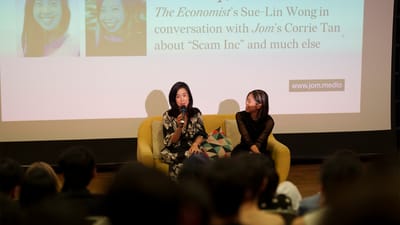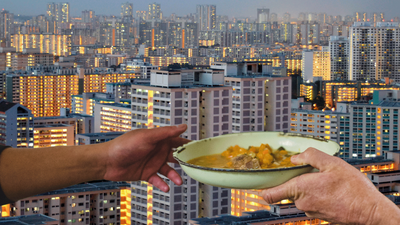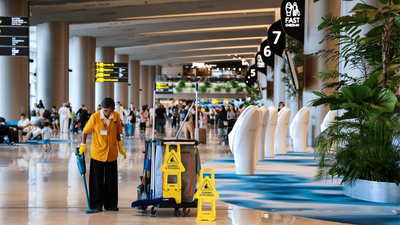“not poor enough to qualify for those smlj subsidies
not rich enoough to live comfortably
sandwich in between basically 吃不饱, 饿不死”
(a Chinese phrase that broadly translates to having enough but not plentiful)
A definition of the “sandwich class” by user 5adisticD3vil on Hardwarezone
On a narrow lane off Serangoon Road is Krsna’s Free Meals, a soup kitchen. “The free food point”, reads the subtext on its white billboard, alongside its pink lotus logo. Unlike the nearby Sri Veeramakaliamman Temple, one of Singapore’s oldest and most distinctive Hindu temples, Krsna would never make it onto any of the Singapore Tourism Board’s “Little India” campaigns. Yet each has its own devoted following. Every morning, Krsna volunteers sort through mounds of potatoes, okras, chillies, cabbage, cucumbers, and other donated vegetables, tossing out the few rotten ones and then peeling and preparing everything else, under the guidance of Krsna’s staff, to make at least 1,000 meals daily. Just minutes from downtown Singapore, where Michelin-starred restaurants serve foie gras and Burgundies, Krsna’s caters mostly to this rich city’s 1-million odd low-wage migrant workers.
That is, until last year. Latha Govindasamy, one of Krsna’s co-founders, started seeing many Singaporean middle-class professionals, in their 20s to 40s, also standing in line for free food. “When we speak to them, they say it’s becoming too expensive to eat out or order online. At least 8 to 10 of them come on alternate days,” the former teacher, in her 50s, observes. Occasionally, even volunteers surreptitiously “bring home extra food or vegetables,” Latha said. “Normally, locals will never take home anything for free. Now, it’s a trend we’re seeing.”
In the broader discourse around inequality, much attention, rightfully, focuses on those at the bottom. Some 30 percent of working households earn less than the amount required to meet basic needs, according to the Minimum Income Standard (MIS) 2023 report, produced by Nanyang Technological University and the LKY School of Public Policy. (The government disagreed with their delineation of “needs” versus “wants”.)
But what about the segment just above them? Living in one of the world’s costliest cities, those Singaporeans face a different kind of financial precarity, one in which they can rarely afford to take a break, never mind have another kid or contend with a health calamity. Life is a constant struggle to ensure that they don’t unwittingly fall into that bottom 30 percent. In order to get a sense for this group’s dynamics, and their struggles, it’s worth first assessing definitions around that generic term, “middle-class”. After all, Singaporeans tend to believe that their country is largely middle-class, the late Adrian Tan, a prominent lawyer, told the BBC last year, despite the presence of the “crazy rich” and the less fortunate. But who is in the middle-class?
Definitions of the middle-class vary significantly between nations, but researchers often define it based on income, for which data is easily accessible. The Organization of Economic Cooperation and Development (OECD), a club of mostly rich countries, defines it as households earning between 75 percent and 200 percent of their respective country’s median income. The World Bank uses a dollar-per-day amount adjusted for purchasing power parity (PPP) to facilitate cross-country comparisons. In 2015, the US-based Pew Research Centre expanded this metric to include four additional income levels, with ‘lower-middle’ and ‘upper-middle’ together constituting the broader middle-class.
China is home to over a third of the global middle-class. Of its 1.4bn population, about 30 percent, or around 400m people, are middle-income earners. The country’s National Bureau of Statistics defines the “middle-income group” as a three-person household earning between 100,000 yuan (S$18,535) and 500,000 yuan (S$95,240) a year. Beijing is keen to double its size to become an advanced economy by the middle of the century. In India, which is more populous but poorer than China, a less stringent definition means that its middle-class is theoretically bigger. The People Research on India’s Consumer Economy (Price), a not-for-profit research firm that conducts household income surveys, classifies middle-class as comprising households earning annually between 500,000 and 3,000,000 rupees (S$8,041 to S$48,236). By that measure, there are about 420m middle-class Indians—about one in every three people–in a segment growing at 6 percent per year, faster than any other. In 2021, the Pew Research Centre estimated that the pandemic may have effectively pushed millions of people, including some 10m in China, out of the middle-class or into poverty. Singapore probably wasn’t immune to this.




